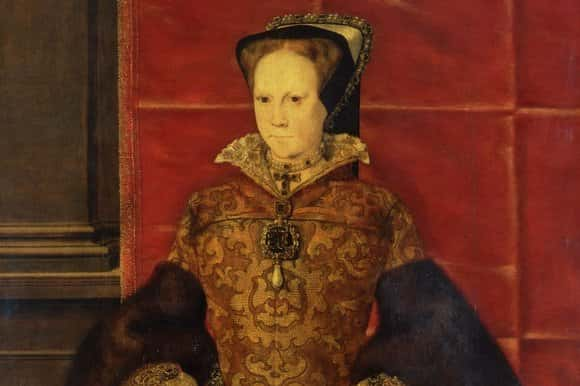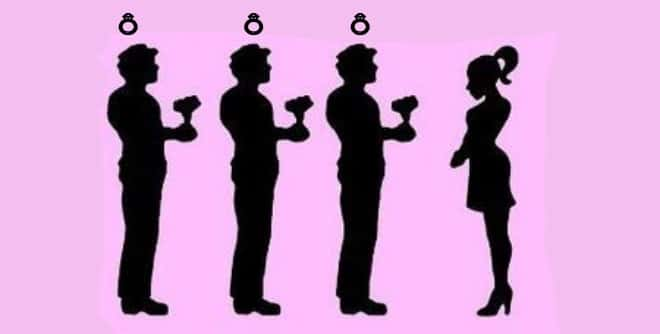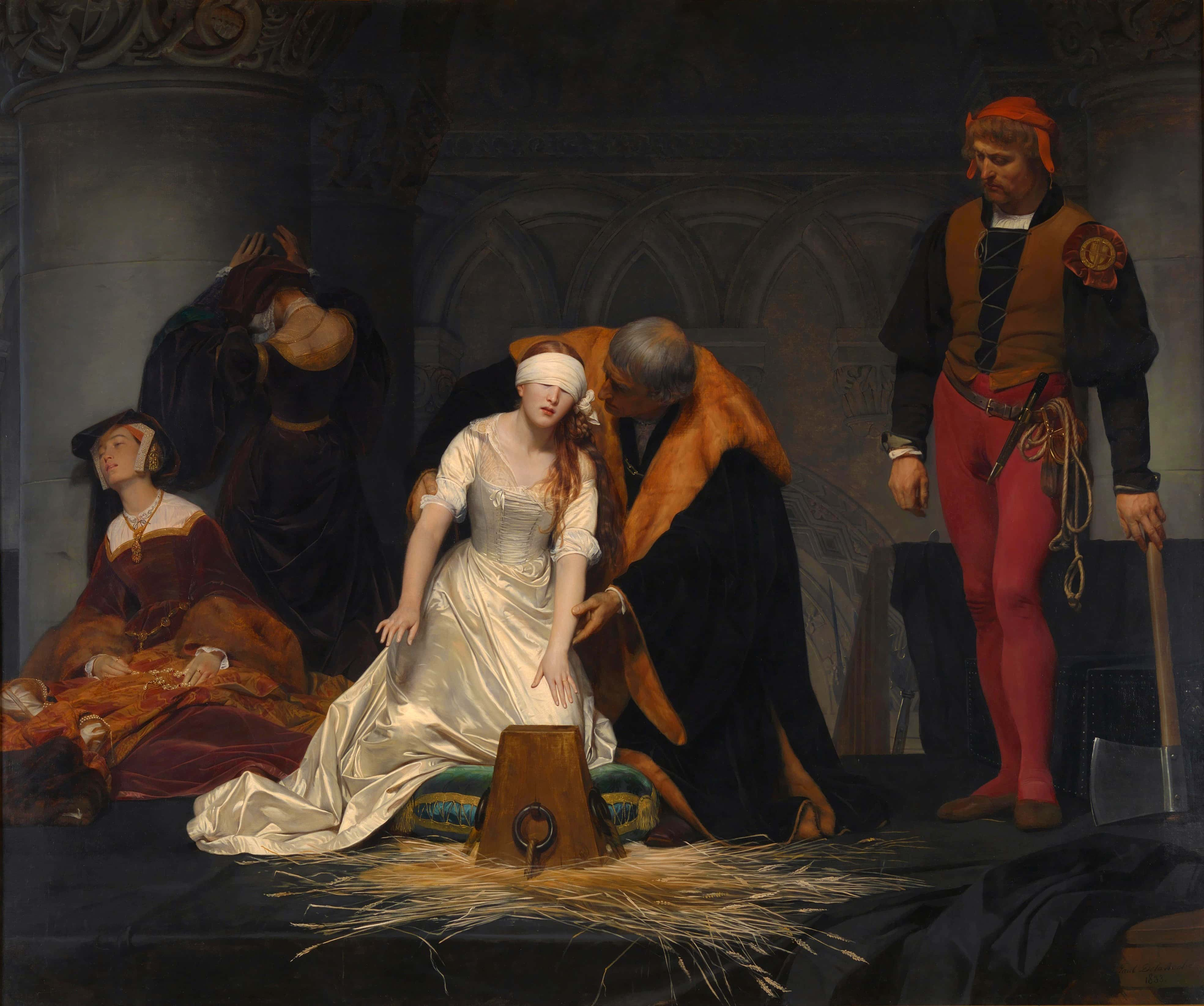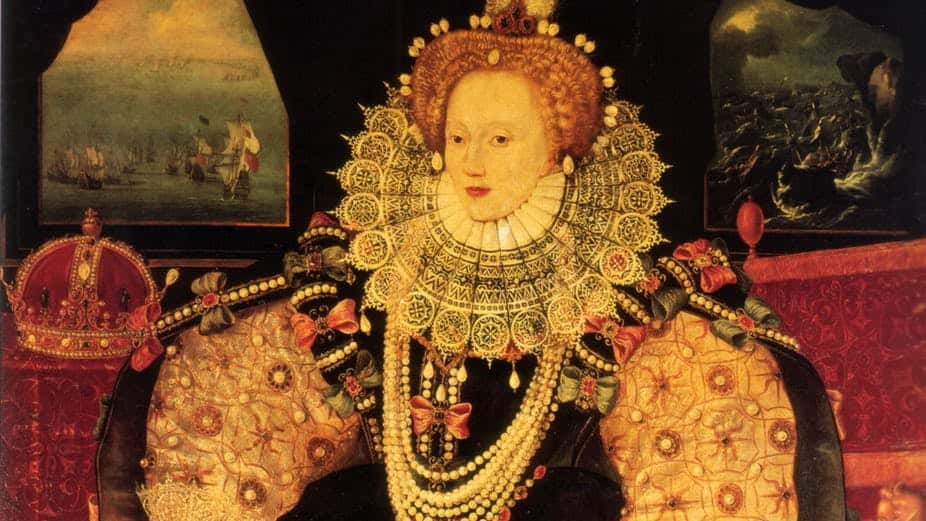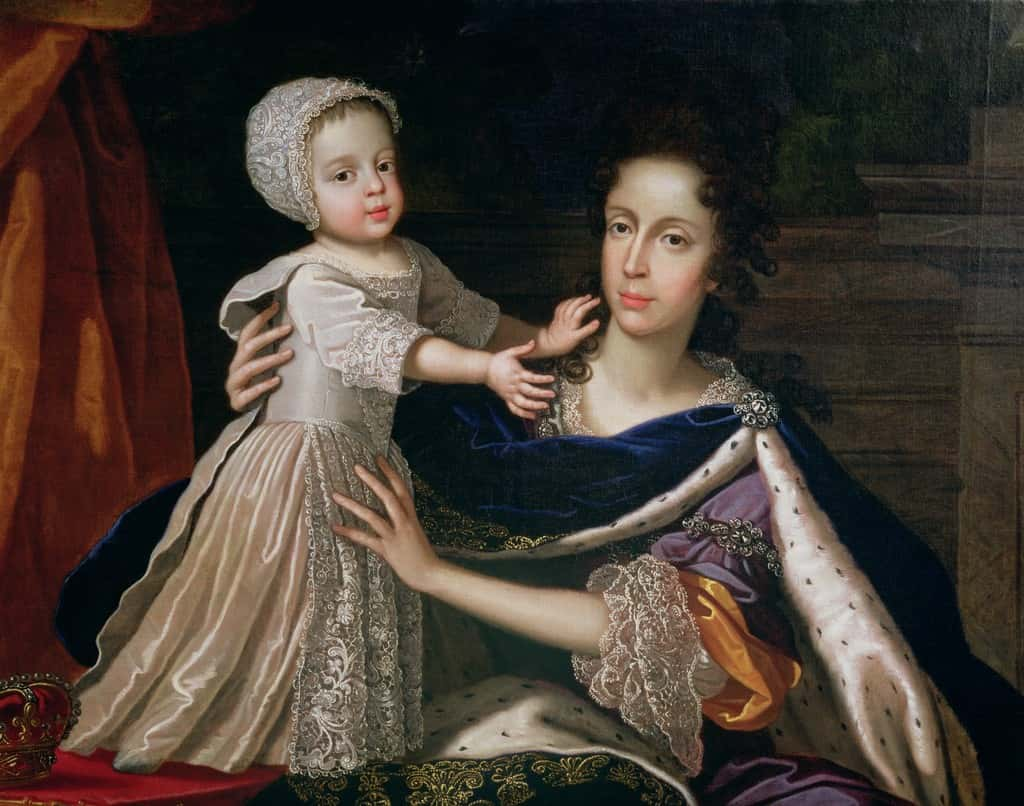Mary Tudor has gone down in the history books as the Catholic tyrant "Bloody Mary." There’s certainly some cause for such a nickname: hundreds of Protestants were executed during her short reign. But there’s much more to her life than her ruthless reputation. She didn’t exactly have the easiest time growing up with a father like Henry VIII. When Henry annulled his marriage to Mary’s mother and rejected the Catholic Church, Mary found herself in exile. Her life was full of tragedy, but it was also one that demonstrated great strength, courage, and tactical brilliance. Here are 41 facts about Bloody Mary that might make you change your perception of the queen.
41. A Tithe of Troubles
Although she only reigned for five years, Mary was a busy Queen. As she attempted to reverse the Protestant reforms started by her father Henry VIII, Mary had over 280 dissenters of the Catholic Church burned at the stake in what was known as the Marian persecutions.
When Mary was only a child, Henry used Protestantism to divorce Mary's mother. It's likely this only fueled Mary's staunch devotion to Catholicism.
 thissideofthetruth - WordPress
thissideofthetruth - WordPress
40. Fated to Rule
It seemed like a miracle that Mary I lived as long as she did, given that she was the only child of Henry VIII and his first wife (of six), Catherine of Aragon. Henry VIII famously separated from the Catholic Church to divorce Catherine in part because she could not produce a living son.
Mary was the only surviving child after Catherine’s previous pregnancies resulted in either a stillborn or a short-lived infant. Catherine also suffered a number of miscarriages before giving birth to Mary.
39. A Message From Our Sponsors
Mary was baptised and confirmed in the Roman Catholic Church shortly after she was born, and her sponsor was quite the figure. Margaret Pole, Countess of Salisbury, was one of only two women in 16th century England to be a peeress, or someone holding a hereditary title, in her own right and not through marriage. Clearly someone who could be counted on!
 theesotericcuriosa.blogspot
theesotericcuriosa.blogspot
38. Hitting the Books
Mary was given quite an extensive education when she was growing up. She learned to play musical instruments like the harpsichord, and studied with Juan Luis Vives, the Spanish humanist who was adored by Catherine of Aragon. As early as age nine, Mary was proficient in Latin, with the ability to both read and write the language.
37. Marriage Alliance
Since Henry VIII was holding out for a son, he saw the young Mary as a great opportunity to forge alliances with other European Kingdoms. By the time she was a teenager, she had already been offered to multiple courts around Europe. And that’s only officially speaking!
36. Child Bride
So determined was Henry VIII to forge an alliance with France that he offered Mary up for marriage when she was just two years old. Given the volatile nature of the time, and especially the capriciousness of a man such as Henry VIII, it came as little surprise that the contract was rescinded only three years later.
35. Like Father, Like Son
Mary eventually married Philip of Spain when she was 37, but several years before that it had been arranged for the young Tudor to marry Charles V of the Holy Roman Empire. Mary was just six at the time of the arrangement and Charles was 22, 16 years her senior. And just to make it clear how small the world of European monarchs was at the time, Charles V was the father of Philip of Spain, her future husband.
Talk about awkward family reunions.
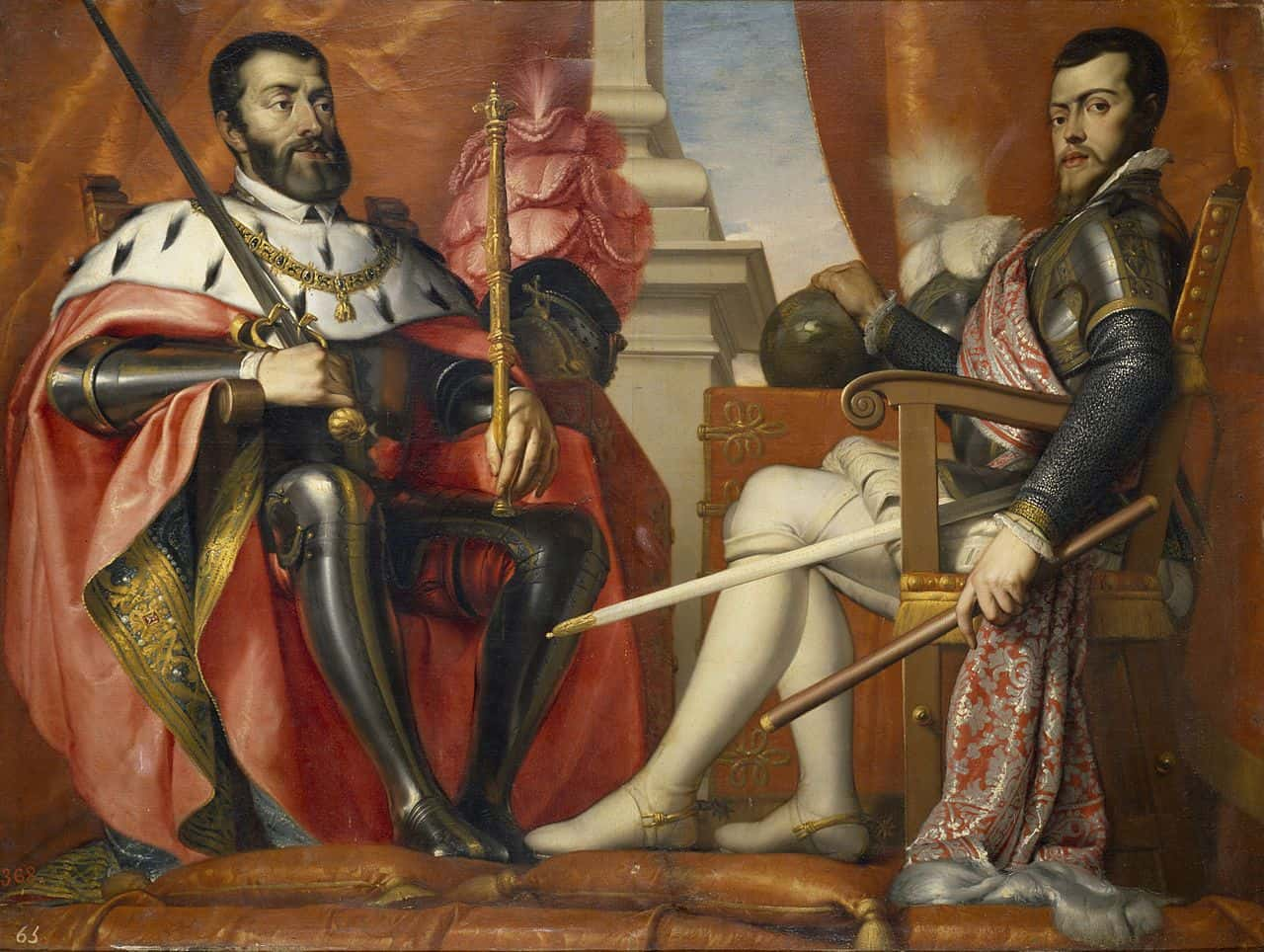 Pinterest
Pinterest
34. Hard Times
As the marriage between Henry VIII and Catherine of Aragon began to suffer, with Henry disappointed by the lack of a male heir, Catherine was sent away from the court. Starting around 1531, Mary became frequently sick (often with irregular menstruation) and was depressed from the inability to see her mother, since she was not allowed to visit.
 Rainhas Consortes
Rainhas Consortes
33. Rags to Riches
Mary’s rise to power was nothing short of a rollercoaster journey. After Henry VIII divorced Catherine of Aragon and married Anne Boleyn, he declared Mary illegitimate and demoted her rank to that of a lady, not an actual princess. Yet Mary would eventually become the first undisputed queen regnant of England.
As opposed to a queen consort, who gains the position by being married to the king, a queen regnant holds all the cards in her own deck.

History's most fascinating stories and darkest secrets, delivered to your inbox daily.
32. What’s Yours Is Mine
After she already persecuted so many Protestants, Mary’s marriage to Philip of Spain stoked fears that England would be put under the rule of the very much Catholic Holy Roman Empire. Of course, Mary wanted a Catholic England, but she also wanted to maintain her grip on power. So she drafted up the "Queen Mary’s Marriage Act" and put it through the parliament.
It stated that although Philip would be given the title “King of England,” he still always had to act with the consent of Queen Mary. The two shared “co-authority,” but the terms were pretty clear. This was Mary’s house.
31. False Alarm
In the summer of 1554, the English court, and indeed most of Europe, was bracing for news of Mary’s first child. Mary started to show signs of a pregnancy months earlier, and everyone was taking precautions for the next heir to the throne. Philip was possibly even planning to marry Mary’s half-sister Elizabeth in the event that his wife died in childbirth (he was a real stand-up guy).
The only problem? Mary wasn’t actually pregnant at all. Perhaps for psychological reasons, Mary had a rare case of false pregnancy, in which a woman shows many of the symptoms of a pregnancy without actually carrying a child.
30. You Can’t Fire Me, I Quit!
When Mary instituted the Heresy Acts, which saw many prominent Protestants around England burned at the stake, it caused a huge drain from the kingdom. A number of intellectuals, such as the historian John Foxe, decided it was better to leave England altogether than face martyrdom at the stake. All told, about 800 Protestants chose exile from England and went to various spots across Europe.
 Alchetron
Alchetron
29. Out of the Will
Despite being the rightful heir to the throne after her brother Edward died young, Mary was excluded from the line of succession at the behest of Duke John Dudley. Instead, Dudley convinced the ailing Edward that his daughter-in-law, Lady Jane Grey, would be a better fit for the throne because she could maintain the Protestant grip on England.
The fear was that Mary could turn the kingdom back to Catholic hands. I mean, he wasn't wrong.
28. Tough Decisions
The ploy didn't work out, and Lady Jane was infamously Queen for only nine days. After Mary took the throne in 1553, she had John Dudley immediately executed for high treason, but faced a difficult position when it came to Lady Jane and her husband, Guildford Dudley. Mary understood that Lady Jane was just a political pawn of the Dudleys, so although she was found guilty of treason, Mary initially kept her under guard at the Tower of London, not wanting to execute her.
However, just as everything seemed to be settling after the whole Steal-the-Throne debacle, further tensions within England about succession forced Mary to execute Lady Jane once and for all. She did so in quite some fashion: public beheading.
27. Say That You Love Me
Although Mary and Philip were married for diplomatic reasons, she came to love Philip dearly, and often expressed her pain when he was away looking after his other territories. Philip, for his part, seemed much more pragmatic—and did not often stay long in England.
 Tea at Trianon
Tea at Trianon
26. A Dubious Honor
Mary was given the nickname "Bloody Mary" because she was so quick to burn Protestants at the stake, her weapon of choice. She certainly used the stake as a means of punishment far more than those who came before and after her. Henry VIII burned 81 people, while Elizabeth I only doled out that particular punishment on five occasions.
As a reminder, Mary's record stood around an impressive 280 people.
25. I Will Not Grant You Three Wishes
When she knew the end was coming, Mary drafted up her Will, which had three specific requests. The First was that the remaining debts of Henry VIII and Edward were paid. Secondly, new religious houses were to be created with money she left. And finally, she requested that her mother’s body be exhumed and buried next to her. All three wishes were ignored after she died.
24. Lose the Battle, Win the War?
Common knowledge has it that Mary was a terrible ruler with a bad military record. This was compounded by her loss of the Pale of Calais, which was the last English stronghold left in France. More recently, however, historians have begun to challenge this judgement of her reign. However, the loss of Calais nonetheless hit Mary hard, and she is reported to have said, “When I am dead and opened, you shall find "Calais" lying in my heart,” although this may have been misreported.
23. All Men Must Die
Mary died, childless, in 1558 during an influenza epidemic. Just the year prior, she thought she might be pregnant once more; but as before, she merely had symptoms of a phantom pregnancy. She was 42 years old at her death.
22. A Softer Side
Despite her persecutions of Protestants and the general appraisal that she was a Catholic zealot, Mary’s actual plans for a return to Catholic Britain were not nearly as hardline as they were made out to be. She took a lot of the concerns of the Reformation seriously, and sought to make sure only respectable and faithful Priests were allowed to preach.
21. Buried Facts
Mary has become somewhat overshadowed in the annals of history by the reign of her sister Elizabeth I, who took over the throne when Mary died. So much so, in fact, that James I, who was Elizabeth’s successor, actually placed Elizabeth’s coffin on top of Mary’s in Westminster Abbey! He then erected a large monument in praise of Elizabeth’s reign, and it only had a small inscription to Mary. That’s just cold.
20. Back by Popular Demand
Once Protestant rule was regained in England after Mary died and Elizabeth took the throne, Mary was quickly framed as a Catholic tyrant. Nonetheless, her Catholic counter-reformation was actually quite popular with the people of England. Many felt that the break with the Catholic Church under Henry VIII was a catastrophic mistake, and wished to return to Catholicism.
 Pinterest
Pinterest
19. Make Peace
Mary never much liked her half-sister Elizabeth. After all, Elizabeth’s mother Anne Boleyn had seduced Henry VIII away from Mary's mother Catherine of Aragon. The only reason why Mary accepted Elizabeth as heir to the throne was because her husband Philip convinced her it was the right decision. Mary, head-over-heels in love with Philip, reluctantly followed his advice.
18. Sister Act
Although Mary was eventually convinced by Philip to allow Elizabeth to be heir to the throne, things almost went a very different path. Mary’s resentment of and competition with Elizabeth caused her to imprison her little half-sister, and Mary even considered executing her, family member or not. Cooler heads eventually prevailed, and the rest is history.
17. Choosing Martyrdom
Mary’s Catholic faith was deeply felt and not just a political ploy. She remained devout even when confronted by her Protestant family. After her brother Edward VI inherited the throne, he confronted Mary, demanding she convert to the Church of England. Mary replied that she would rather be executed than deny her faith.
16. A Heretical Movement
Part of Mary’s strategy to return the supremacy of the Pope and the rule of the Catholic Church in England was to reinstate old heresy laws that had gone by the wayside when Henry VIII turned to Protestantism. The laws listed heresy as a treasonable offence, and treason meant execution. With the reinstatement of these laws, Mary was able to execute many Protestants within a short three year period.
15. Mommie Dearest
When Mary's mother Catherine of Aragon died in 1536, Mary was reportedly "inconsolable," and she shut herself away in a remote estate to grieve in private.
14. Spreading Rumors
After it became clear to everyone that Mary was not in fact going to be giving birth to a child, the rumor mill went into overdrive. Across England, stories sprung up to explain the unusual events of Mary's "pregnancy." Some claimed she kept a miscarriage secret, others that the pregnancy was always fake and that Mary was going to smuggle in a baby to pose as her own.
Others suggested that Mary was actually ill and had convinced herself that she was not sick and just pregnant.
 BESTqUEST - WordPress
BESTqUEST - WordPress
13. Lasting Legacy
Mary might have been overshadowed by her successor Elizabeth, but one story of hers took on an afterlife of its own. Mary’s false pregnancy spurred rumors a century later that the child of James II and Mary of Modena was actually an impostor child, smuggled in to convince the people of a new heir to the throne of England.
The rumors specifically cited the events of Bloody Mary’s reign, as Mary of Modena was also a Catholic.
12. A Queen With Pedigree
For most of history, Mary was branded a religious zealot and tyrant, but she also was highly successful when it came to restructuring the English economy, the militia, and the management of parliament. She also rebuilt the navy, which became an essential part of the success that Elizabeth I had during her reign.
11. Even After You're Gone
John White, Bishop of Winchester, provided the sermon for Mary’s funeral in 1558. A Roman Catholic who rose to prominence under Mary’s reign, he spoke of the deceased queen in heartfelt terms. The praise of her mission for Catholic justice was, perhaps, too praising, and one of Elizabeth’s first actions was to have White imprisoned.
Easy come, easy go.
10. The Gambler
Mary was apparently quite the card shark in her day. Throughout her life, she was fond of buying lavish new playing cards, and was an avid gambler. A study of her account books suggest she was not the luckiest player, as she counted a number of losses. Like her mother, Mary also loved to play chess.
9. Cool New Stepmom
After being exiled out of the court when Henry VIII married Anne Boleyn, Mary was eventually permitted back to the court. In the last years of her father's life, Mary became quite close with her new stepmother, Henry's last wife Catherine Parr. The two shared a lot in common, including a love of card games and chess.
 englishhistoryauthors.blogspot
englishhistoryauthors.blogspot
8. Brotherly Love
Mary also had a warm relationship with the Henry's third wife Jane Seymour. The queen even chose Mary to be the godmother of Prince Edward.
 Wikipedia
Wikipedia
7. I’ll Be Missing You
Mary’s relationship to Jane Seymour stood in stark contrast with her resentful attitude toward Anne Boleyn. When Seymour died in 1537, Mary was given the role of chief mourner at her funeral.
6. Mass Effect
Mary absolutely refused to recognize the 1549 Prayer Book, which was the official prayer book for the newly conceived Church of England. Since her cousin was the Holy Roman Emperor, Mary, still a princess, gained some protection and was allowed to continue to receive the Catholic mass in her private chapel. But Mary used this personal favor to set up her own mini mission: she invited others to hear Mass in her chapel, which continued to grow with each passing week.
Eventually, the court put a stop to these Catholic masses and did not allow Mary to continue in her own chapel.
 Today In British History
Today In British History
5. Vengeance for My Mother
Execution of prominent Protestant voices was a common feature of Mary’s reign, but for the most part these coincided with the heresy laws that she enforced. One execution, though, was a bit more personal in nature. Mary was directly involved with the arrest and execution of the Archbishop of Canterbury, Thomas Cranmer.
Cranmer was the one who pronounced the marriage of Henry VIII and Catherine of Aragon, her mother, invalid. Mary clearly never let that go, and even though Cranmer recanted his Protestant beliefs, she executed him anyway.
 atpaperjfrl.automator.me
atpaperjfrl.automator.me
4. Single and Ready to Mingle
Once Mary died, her widower Philip started trying to marry her sister Elizabeth, just as he had planned when he worried Mary might die in childbirth. As in his marriage to Mary, Philip was mostly interested in maintaining a strong Catholic alliance with England. Elizabeth was having none of it, however, and rejected the proposal.
3. Cunning Like a Foxe
Even though Mary was rather zealous when it came to persecuting Protestants in England, it still can't be said that she was more bloody than her father, Henry VIII. Henry executed somewhere between 57,000 and 72,000 people during his reign, and of course ordered the execution of not one but two of his very own wives. So why is Mary I still referred to as "Bloody Mary"?
Part of the answer lies in the figure of John Foxe. An exiled but popular Protestant historian, Foxe wrote extensively on persecuted protestants, and his work, still in print, has kept this dark aspect of Mary's reign alive throughout the centuries.
2. Cause of Death
The reasons for Mary’s death are not totally clear. Some accounts suggest she succumbed to the influenza outbreak that occurred in England in 1558. Others suggest she possibly died of cancer, and that her false pregnancy was actually the result of a tumor.
1. Utmost Certainty
During one of her false pregnancies, Mary herself was so convinced that she was with child that she had letters drafted announcing the birth of her heir, the next ruler of England. Sadly, the letters would never be needed.


